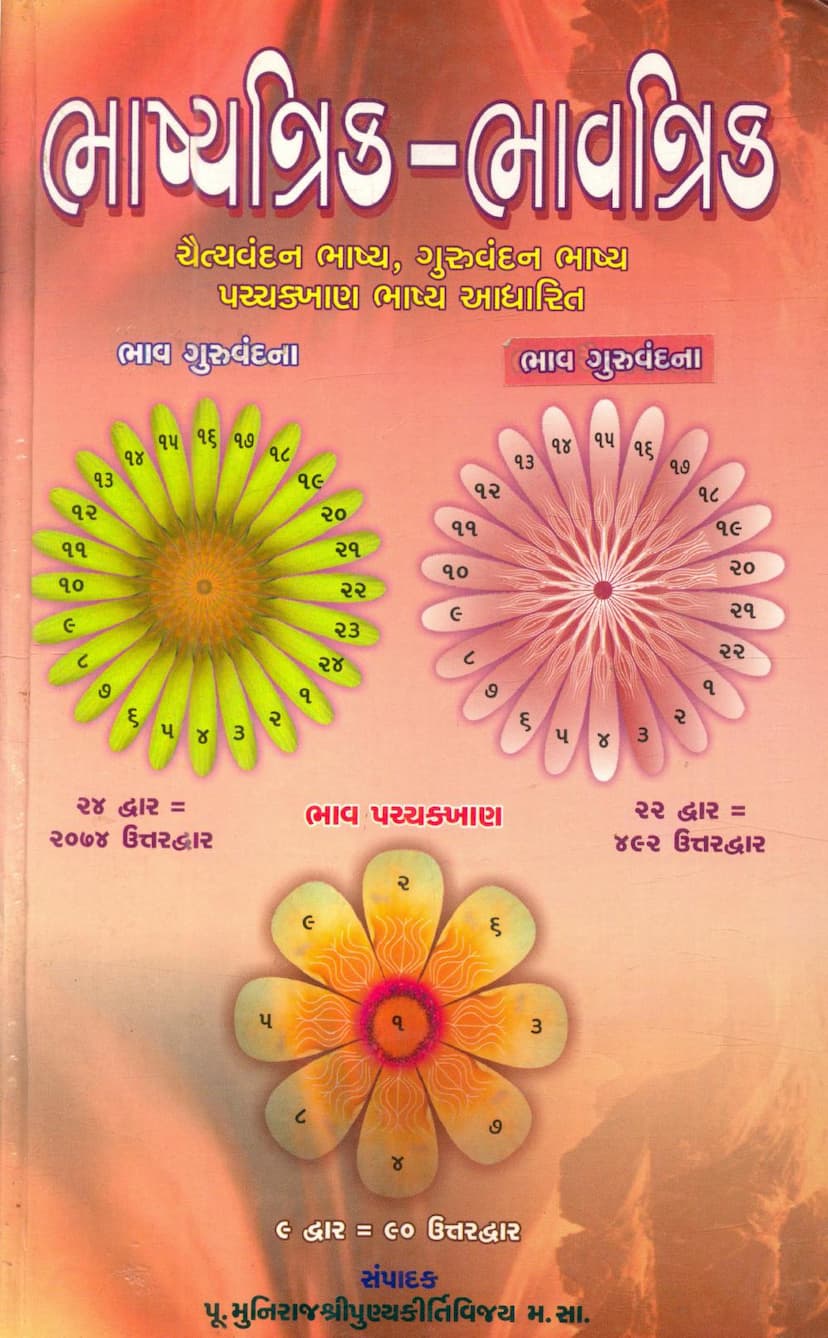Bhashyatrik Bhavtrik
Added to library: September 1, 2025

Summary
The book "Bhashyatrik Bhavtrik" by Punyakirtivijay, published by Sanmarg Prakashan, is a comprehensive guide to essential Jain practices, focusing on the three core elements of devotion: Dev (God), Guru (Teacher), and Dharma (Religion). The title itself, "Bhashyatrik Bhavtrik," signifies this tripartite focus, with "Bhashya" indicating commentary or explanation and "Bhav" referring to the devotional or inner aspect.
The book is structured around three major sections, each dedicated to one of these pillars:
-
Bhashya Chaitravandan (Devotional Worship of Jin-Idols): This section delves into the meticulous details of worshipping the Tirthankaras (Jinas) in Jain temples. It is based on the 24 "Dwar" (gates or principles) and 2074 "Uttar Dwar" (sub-principles) outlined in the Chaitravandan Bhashya. The book explains the proper procedure for performing Chaitya Vandan, including:
- The 24 Dwar and 2074 Uttar Dwar: These are categorized and explained, covering various aspects of the worship ritual.
- Rituals and Offerings: The text details the correct way to perform different types of worship (Pooja) such as Ashtaprakari Pooja (eight types of offerings), Navang Pooja (worship of nine limbs), and the significance behind each action.
- Understanding the Divine Form: It guides the reader on meditating on the different states of the Tirthankaras (e.g., childhood, royalty, asceticism) and appreciating the concept of Pratiharayas (eight auspicious signs of divinity).
- Proper Conduct in the Temple: The text emphasizes the importance of maintaining focus, correct posture (mudras), and avoiding temple transgressions (Ashata).
- Understanding the Sutras: It breaks down the various sutras (scriptural verses) used in worship, explaining their literal meaning, components (varnas, padas, sampada), and the appropriate context for their recitation. This includes detailed analysis of the number of letters (akshars), words (padas), and resting points (sampada) within key sutras.
-
Bhashya Guruvandana (Devotional Salutation to the Guru): This section focuses on the reverence and respect due to Jain monks and spiritual teachers. It is based on the 22 "Dwar" and 492 "Uttar Dwar" of Guruvandan. The book outlines:
- The Importance of the Guru: Emphasizing the scriptural adage that "knowledge is not without a Guru," the text highlights the Guru's role in guiding disciples towards right knowledge and conduct.
- Types of Gurus and Salutations: It differentiates between worthy and unworthy monks and explains the various forms of salutation (Vandan Vidhi) suitable for different situations and relationships.
- Proper Etiquette for Guruvandan: This includes detailed instructions on how and when to approach the Guru, the correct mudras and postures to adopt, the specific sutras to recite, and the 33 types of Ashata (transgressions) to avoid when interacting with or saluting the Guru.
- The Significance of the 12 Dwar: The text elaborates on the 12 principles of Guruvandan, including the importance of observing the Guru's discipline, understanding their teachings, and maintaining proper conduct.
-
Bhashya Pacchakkhan (Vow-Taking and Renunciation): This crucial section deals with the practice of taking vows (Pacchakkhan) and the principles of renunciation (Virati) in Jainism. It is based on the 9 "Dwar" and 90 "Uttar Dwar" of Pacchakkhan. The book explains:
- The Essence of Virati (Renunciation): It clarifies that Virati is the direct outcome of the knowledge gained from the Guru and forms the foundation of Dharma.
- Types of Pacchakkhan: The text categorizes different types of vows, such as those related to food (Asana, Pana, Khadima, Swadima), the 22 "Aagar" (exemptions or permissible allowances within a vow), 10 "Vigai" (foods that are modified or considered less pure), and 30 "Niviyata" (specific restrictions).
- The Process of Vow-Taking: It provides a step-by-step guide on how to correctly take vows, including the associated rituals, prayers, and the importance of understanding the underlying principles.
- The Purpose and Benefits of Pacchakkhan: The book explains how these vows help in controlling desires, reducing the influx of karma, and ultimately pave the path towards liberation. It also discusses the fruits (Phala) of observing these vows, both in this life and the next.
Overall Theme and Significance:
"Bhashyatrik Bhavtrik" emphasizes the interconnectedness of devotion to God, Guru, and Dharma. It aims to transform ritualistic practices into deeply felt devotional experiences ("Bhav"). The author, Punyakirtivijay, has meticulously compiled this knowledge, providing a detailed and accessible guide for Jain practitioners. The book highlights the importance of both knowledge (Gyan) and action (Kriya) as the two wheels of the chariot leading to liberation, illustrating this with the analogy of a blind man carrying a lame man.
The book's structure with its "Dwar" and "Uttar Dwar" system provides a systematic approach to understanding and practicing these core Jain tenets, making it a valuable resource for those seeking to deepen their spiritual understanding and practice within the Jain tradition. The publisher, Sanmarg Prakashan, is known for disseminating authentic Jain literature, and this work is a testament to that commitment.